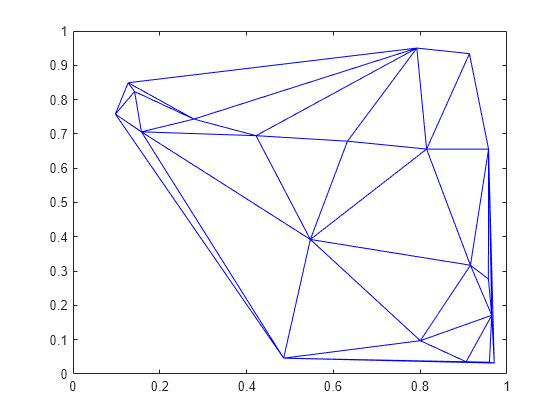DelaunayTri
(不推荐)二维和三维德劳内三角剖分
不推荐使用 DelaunayTri。请改用 delaunayTriangulation。
说明
DelaunayTri 基于一组点创建德劳内三角剖分对象。可以通过添加或删除点对三角剖分执行增量修改。在二维三角剖分中,您可以实行边约束。您可以执行拓扑和几何查询,然后计算沃罗诺伊图和凸包。
创建对象
语法
描述
输入参量
属性
对象函数
除了以下对象函数之外,DelaunayTri 对象还支持使用括号 () 对三角剖分进行索引。此语法与数组语法相同。
baryToCart | (不推荐)将点坐标从重心坐标转换为笛卡尔坐标 |
cartToBary | (不推荐)将点坐标从笛卡尔坐标转换为重心坐标 |
circumcenters | (不推荐)指定的单纯形的外心 |
convexHull | (不推荐)德劳内三角剖分的凸包 |
edgeAttachments | (不推荐)连接到指定边的三角形或四面体 |
edges | (不推荐)三角剖分边 |
faceNormals | (不推荐)指定的三角形的单位法向量 |
featureEdges | (不推荐)曲面三角剖分的锐边 |
freeBoundary | (不推荐)自由边界面 |
incenters | (不推荐)指定单纯形的内心 |
inOutStatus | (不推荐)二维约束德劳内三角剖分中三角形的状态 |
isEdge | (不推荐)测试顶点是否通过边相连接 |
nearestNeighbor | (不推荐)最靠近指定点的顶点 |
neighbors | (不推荐)三角形或四面体邻点 |
pointLocation | (不推荐)包围点的三角形或四面体 |
size | (不推荐)三角剖分矩阵的大小 |
vertexAttachments | (不推荐)连接到顶点的三角形或四面体 |
voronoiDiagram | (不推荐)德劳内三角剖分的沃罗诺伊图 |
示例
详细信息
提示
当边界约束相交或重叠时,
DelaunayTri会产生不正确或不一致的结果。为了避免这种行为,请使用能够构成一个或多个不相交、不重叠的闭合边界的约束。
版本历史记录
在 R2009a 中推出
